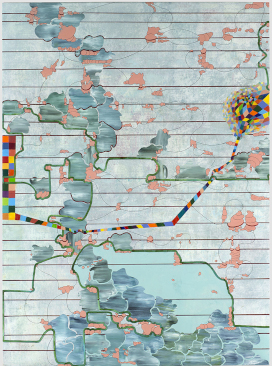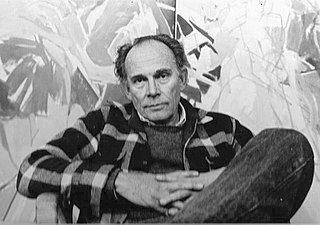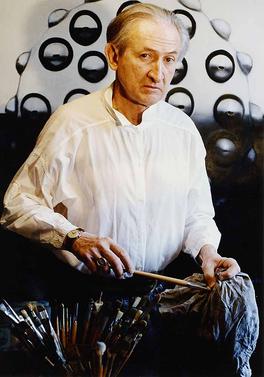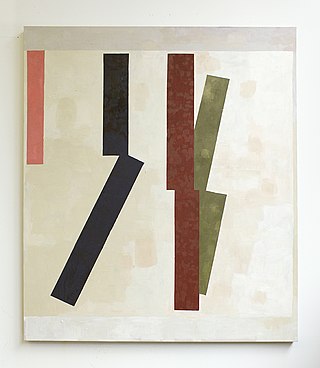
Derek Fordjour is an American interdisciplinary artist and educator of Ghanaian heritage who works in collage, video/film, sculpture, and painting. Fordjour lives and works in New York City.
Minus Space is an art gallery located in Dumbo, Brooklyn, NY. It specializes in abstract art and reductive art.

Cora Cohen was an American artist whose works include paintings, drawings, photographs, and altered x-rays. Cohen is most known for her abstract paintings and is often identified as continuing the tradition of American Abstraction. In a 2023 review in Artforum Barry Schwabsky suggested that "Cohen’s determination to evade stylistic consistency has made her one of the most underrated painters in New York." The New York Times' critic Michael Brenson wrote of her 1984 exhibition, Portraits of Women: "The works are dense, brooding and yet elated. The turbulence of the paint not only looks but also feels like freedom." Cohen interviewed many other artists also associated with continuing the tradition of American Abstraction for Bomb Magazine including; Ralph Humphrey, Dona Nelson, Craig Fisher, Carl Ostendarp, and Joan Mitchell. Her work has also been identified with traditions of European abstraction, and specifically German abstraction, including the work of Wols, Sigmar Polke, Gerhard Richter. She began exhibiting in Germany in the early nineties and continued to show at some of its most prestigious institutions.

Katherine Bradford, née Houston, is an American artist based in New York City, known for figurative paintings, particularly of swimmers, that critics describe as simultaneously representational, abstract and metaphorical. She began her art career relatively late and has received her widest recognition in her seventies. Critic John Yau characterizes her work as independent of canon or genre dictates, open-ended in terms of process, and quirky in its humor and interior logic.
George Earl Ortman was an American painter, printmaker, constructionist and sculptor. His work has been referred to as Neo-Dada, pop art, minimalism and hard-edge painting. His constructions, built with a variety of materials and objects, deal with the exploration off visual language derived from geometry—geometry as symbol and sign.

Ted Stamm (1944-1984) was an American minimalist and conceptualist artist.
Judith Bernstein is a New York artist best known for her phallic drawings and paintings. Bernstein uses her art as a vehicle for her outspoken feminist and anti-war activism, provocatively drawing psychological links between the two. Her best-known work features her iconic motif of an anthropomorphized screw, which has become the basis for a number of allegories and visual puns. During the beginning of the Feminist Art Movement, Bernstein was a founding member of the all-women's cooperative A.I.R. Gallery in New York.

Gerry Hayes is an American painter who in addition to his paintings, has created installation sculpture and conceptual ideas documented in photography.
Catherine Murphy is an American realist painter whose career began with the inclusion of her work in the 1971 Annual Exhibition of Painting and Sculpture at the Whitney Museum of American Art. A two-time recipient of the National Endowment of the Arts grant, Murphy has received numerous awards and honors for her work, including a Guggenheim Fellowship (1982) and most recently the Robert De Niro, Sr. Prize in 2013. She was a Senior Critic at Yale University Graduate School of Art for 22 years and is currently the Tepper Family Endowed Chair in Visual Arts at the Mason Gross School of the Arts at Rutgers.

Lisa Corinne Davis is an American visual artist known for abstract paintings and works on paper that suggest maps and other encoded forms of knowledge. She employs abstraction as a means of rendering the complexities of contemporary experience—including her own as an African-American woman—often questioning preconceived notions about identity, classification, and rationality versus subjectivity. Her densely layered, colorful work merges contrasting schemas, visual elements and formal languages, blurring distinctions between figuration and abstraction, real and fictive spaces and concepts, and microcosmic or macrocosmic reference. Brooklyn Rail critic Joan Waltemath wrote, "The urban experiences of space and time that Davis presents are subtle distillations of moment and coincidence ... Her attempt to map the shattered terrain of contemporary life points both to an awareness of other times and a belief in navigating the present one."
Jacolby Satterwhite is an American contemporary artist who creates immersive installations. He has exhibited work at the Minneapolis Institute of Art, the Museum of Contemporary Art, Chicago, Louis Vuitton Foundation in Paris, the New Museum and the Museum of Modern Art, both in New York City, and the Institute of Contemporary Art, Philadelphia. In addition to MoMA, his work is in the public collections of the Studio Museum in Harlem, the Seattle Art Museum, the Whitney Museum of American Art, the Kiasma, and the San Jose Museum of Art. Satterwhite has also served as a contributing director for the music video that accompanied Solange's 2019 visual album When I Get Home and directed a short film accompaniment to Perfume Genius's 2022 studio album Ugly Season.

Norman L. Kleeblatt is a curator, critic, and consultant based in New York City. A long-term curator at the Jewish Museum in New York, he served as the Susan and Elihu Rose Chief Curator from 2005 to 2017.

Mernet Larsen is an American artist known for idiosyncratic, disorienting narrative paintings that depict a highly abstracted, parallel world of enigmatic and mundane scenarios. Since 2000, her work has been characterized by flat, origami-like figures composed of plank-like shapes and blocky volumes and non-illusionistic space with a dislocated, aggregated vision freely combining incompatible pictorial systems—reverse, isometric, parallel, and conventional Renaissance perspectives—and various visual distortions. Critics have described her approach as "a heady, unlikely brew" taking compositional cues from wide-ranging sources, including the modernist geometries of Constructivist artists like El Lissitzky, Japanese Bunraku puppet theater and emaki narrative scrolls, early Chinese landscapes, and Indian miniatures and palace paintings. Roberta Smith wrote that Larsen's works "navigate the divide between abstraction and representation with a form of geometric figuration that owes less to Cubo-Futurism than to de Chirico, architectural rendering and early Renaissance painting of the Sienese kind. They relish human connection and odd, stretched out, sometimes contradictory perspectival effects, often perpetuated by radical shifts in scale."
Elena Sisto is an American painter based in New York.

Gary Stephan is an American abstract painter born in Brooklyn who has exhibited his work throughout the United States and Europe.
Ann Pibal is an American painter who makes geometric compositions using acrylic paint on aluminum panel. The geometric intensity is one of the key characteristics that defines her paintings.

Charles Florian Cajori was an abstract expressionist painter who, through his drawing, painting and teaching, made a significant contribution to the New York School of artists that emerged in the 1950s.

Agustín Fernández was a Cuban painter, sculptor, and multimedia artist. Although he was born in Cuba, he spent the majority of his career outside of Cuba, and produced art in Havana, Paris, San Juan, and New York.

Sharon Butler is an American artist and arts writer. She is known for teasing out ideas about contemporary abstraction in her art and writing, particularly a style she called "new casualism" in a 2011 essay. Butler uses process as metaphor and has said in artist's talks that she is keenly interested in creating paintings as documentation of her life. In a 2014 review in the Washington Post, art critic Michael Sullivan wrote that Butler "creates sketchy, thinly painted washes that hover between representation and abstraction.Though boasting such mechanistic titles as 'Tower Vents' and 'Turbine Study,' Butler’s dreamlike renderings, which use tape to only suggest the roughest outlines of architectural forms, feel like bittersweet homages to urban decay." Critic Thomas Micchelli proposed that Butler's work shares "Rauschenberg’s dissolution of the barriers between painting and sculpture," particularly where the canvases are "stapled almost willy-nilly to the front of the stretcher bars, which are visible along the edges of some of the works."

Harriet Korman is an American abstract painter based in New York City, who first gained attention in the early 1970s. She is known for work that embraces improvisation and experimentation within a framework of self-imposed limitations that include simplicity of means, purity of color, and a strict rejection of allusion, illusion, naturalistic light and space, or other translations of reality. Writer John Yau describes Korman as "a pure abstract artist, one who doesn’t rely on a visual hook, cultural association, or anything that smacks of essentialization or the spiritual," a position he suggests few post-Warhol painters have taken. While Korman's work may suggest early twentieth-century abstraction, critics such as Roberta Smith locate its roots among a cohort of early-1970s women artists who sought to reinvent painting using strategies from Process Art, then most associated with sculpture, installation art and performance. Since the 1990s, critics and curators have championed this early work as unjustifiably neglected by a male-dominated 1970s art market and deserving of rediscovery.












